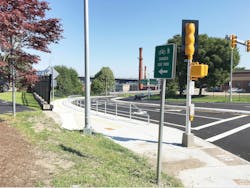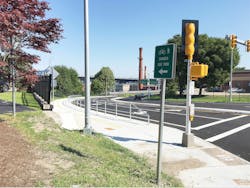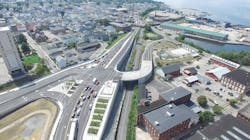Bridging communities
When final design and construction launched in 2013 on the Massachusetts Department of Transportation’s (MassDOT) Rte. 79/I-195 Interchange Reconstruction and Braga Bridge Improvements project in downtown Fall River, safety, accessibility, traffic management and community enhancement served as the primary objectives.
The $228 million design-build project, part of MassDOT’s historic $3 billion Accelerated Bridge Program, was awarded to the joint venture of Barletta Heavy Division and O&G Industries, with VHB serving as lead design consultant. The 1960s-era bi-level Rte. 79 viaduct and associated interchange ramp system were in serious disrepair, considered both structurally deficient and functionally obsolete. Ongoing maintenance and emergency repairs led MassDOT to consider options for full-scale rehabilitation or reconstruction, eventually settling on an option to reconfigure the interchange as a more substantially at-grade system.
The project included the replacement of the viaduct with a new, widened surface roadway, as well as a simplification of the tangled ramp system, dubbed the “Spaghetti Ramps” by local residents. The scope of work for the reconfiguration included construction of nine new bridges; 75,000 sq ft of retaining wall; eight signalized intersections, including a new adaptive signal control system; 2 miles of shared-use path and dedicated bike lanes; structural repairs and painting of the mile-long Braga Bridge over the Taunton River; and significant upgrades to both state and city utility infrastructure. The reconstruction involved significant challenges, including an aggressive schedule, complex traffic management and construction phasing, unknown subsurface utility information, and a site woven through a historic urban location. Since completion in 2016, the reconfiguration and upgrades have dramatically improved vehicular, pedestrian and bicycle facilities throughout the project limits, and restored local connections to the Taunton River waterfront.
Addressing structural deficiencies
The existing interchange was comprised of 11 separate structures totaling 111 spans. Of these structures, 10 were classified as structurally deficient with 94% of the steel rated deficient and requiring costly emergency repairs. The project included the removal of all deficient structures and replacement with nine new bridges, representing a substantial reduction in aerial structure and associated life-cycle repair and maintenance costs. The new bridges included eight steel girder superstructures and one prestressed concrete deck beam superstructure. Two of the bridges, Ramps C and G, consisted of multi-span curved girder systems with long, tight radius spans configured to avoid landing of supports within the interstate and city intersections below. The existing Davol Street bridge, threaded through narrow gaps between the city’s historic mill buildings, was reconstructed to the maximum possible width to accommodate over 50,000 vehicles per day (vpd) and serve as the primary north-south link between the newly constructed Rte. 79 and Rte. 138 surface roadways on either end. This 630-ft-long, 78-ft-wide structure was constructed using splayed girders to accommodate a variable width roadway between the buildings, dapped girder ends to minimize the structure depth over a railroad below, and precast tub section pier caps to minimize the impacts to rail operations.
Along with the complete reconstruction of the interchange, this project included substantial concrete and steel repairs, painting and retrofitting of the mile-long Braga Bridge carrying I-195 over the Taunton River between Fall River and Somerset, Mass. This endeavor accelerated and completed a long-running rehabilitation program which had impacted traffic on the bridge relentlessly since 2010. Concrete deck and joint repairs, structural steel repairs to the main span truss and approach span girders, and significant repairs to the many concrete pier caps and columns dramatically improved the bridge condition. The existing structure was designed with “pin-and-hanger” assemblies in five locations along the main girders. These details are considered fracture-critical, meaning that they are non-redundant and their failure could result in partial or full collapse of the structure. To retrofit these details, massive “catcher beam” assemblies were installed at each location with the function of supporting the girders in the event of failure of the pin and hanger mechanisms.
A more at-grade solution allowed for bike paths, shared-use paths and wheelchair ramps, and the widening of shoulders and sidewalks.
Traffic safety, accessibility, community enhancement
The Rte. 79/I-195 Interchange lies between Fall River’s busy downtown communities and the substantial cultural and historic resources along the Taunton River waterfront. The existing elevated structures formed a major physical and visual barrier between the neighborhoods and the water, and cast shadows on dangerous, unsignalized intersections below. While the primary goal of the project focused on the infrastructure deficiencies, the reconstruction presented a unique opportunity to improve access and safety for secondary roadway users and to re-establish vital connections between downtown Fall River and the waterfront. Design of roadway systems was advanced with a complete streets approach, considering all roadway users and incorporating safe accommodations for bicyclists and pedestrians wherever possible. In two locations, the construction of new shared-use paths allowed for designated bicycle and pedestrian routes, separated from vehicular traffic. All new intersections were designed to minimize conflicts between the different traffic modes and adhere to current accessibility standards, dramatically improving pedestrian and bicycle routes for users of all ages and abilities.
“The project need in this historic area was to reconstruct the aging and deteriorating transportation infrastructure, but the opportunity was to enhance the community of Fall River by re-establishing connections to the underutilized Waterfront District,” said MassDOT Project Manager Amy Getchell. “VHB identified this as a high-priority objective for the project and promoted the reconnection throughout design wherever practical.”
When a project can effectively balance infrastructure needs with environmental stewardship and a focus on the health, safety and livability of the local population, it can significantly benefit the enhancement of vibrant and sustainable communities. Elimination of this barrier and improvement in bicycle and pedestrian accommodations was a critical step forward in the city of Fall River’s Master Plan, which identified the waterfront area as a primary focus for economic and tourism development, and placed significant emphasis on the need to reconnect the area to adjacent neighborhoods.
“Removing those barriers and structures was completely like night and day for the project area,” said Barletta Heavy Division Project Manager Howard Goldberg. “It opened up the view to the waterfront, and it opened up a lot of area that had been in the shadows for a long time.”
Keeping people moving
I-195 serves as a critical east-west link through Massachusetts and Rhode Island, carrying upwards of 90,000 vpd along a primary route linking New York, Connecticut and Rhode Island to Cape Cod. Demolition of the existing two-level Rte. 79 viaduct and reconfiguration of the I-195 ramp system required displacement of as many as 50,000 vpd, consisting of both local and regional roadway users. As can be expected on a major transportation infrastructure reconstruction project, a primary objective was to minimize traffic impacts during construction while maintaining work zones to support critical path activities.
Collaborating closely with MassDOT and the city of Fall River, the project team developed complex staging and traffic management plans with a focus on roadway user and construction worker safety. To minimize traffic impacts, the team carefully evaluated traffic demands and the anticipated impacts of major construction activities. Early release for construction packages allowed for the rapid implementation of temporary ramp connections, critical utility relocations, and brand new bridges and roadways to allow traffic to more easily circumvent the site, all leading to a reduced overall project duration. Detailed traffic control and detour plans were developed to carefully balance and coordinate work-zone needs for the interchange reconstruction, repair work along I-195 and the Braga Bridge, as well as work being completed on separate construction contracts nearby.
“Our team treated each individual traffic stage as its own project,” said New England Regional Manager Tom Jackmin. “We had several major construction phases, and every one of them had to consider not only traffic volumes, but how we would provide safe and efficient access across the site for the many pedestrian and bicyclists using the local system. Balancing mobility solutions for these users during all construction phases was critical to the success of the project.”
Cutting-edge technologies were employed to deliver continuous real-time communications and traffic signal adjustments. Incorporation of the real-time traffic management (RTTM) system helped communicate ongoing project information and travel times to the motoring public. The RTTM featured the installation of a robust system of Bluetooth readers and hybrid message signs located within the project limits and strategically throughout the regional highway network. Additionally, the new permanent adaptive signal control system installed along the Rte. 79 intersections allowed for signal timings to automatically adjust based on detected traffic needs at that time. These tools allowed the team to deliver on promises to minimize impacts to the traveling public and local communities.
Keeping traffic moving safely and efficiently during construction activities is vital to the successful delivery of complex infrastructure projects and is oftentimes the most visible aspect to the traveling public. Perhaps the most important traffic management tool for a project involving substantial traffic volumes is early, open and honest communication with the public. From the beginning, it was clearly communicated that this project would be disruptive. Throughout construction, the project team focused on comprehensive public outreach, including stakeholder briefings, e-mail communication, a project website, social media and press updates. By keeping the traveling public informed of upcoming traffic shifts, the team was able to eliminate significant travel delays throughout the duration of the project.
The Rte. 79/I-195 project included the replacement of the viaduct and simplification of the tangled ramp system.
Quick results
The design and construction teams collaborated closely on creative design solutions to address the many schedule and constructability challenges encountered on the project. The design approach on all major structural elements was to avoid or otherwise reduce the duration of any construction that would impact traffic flow. This led to optimization of span configurations on several bridges to avoid lengthy work within active roadways or railroads, and the use of prefabricated bridge components where beneficial to minimize shutdowns for traffic below. Whereas the existing elevated interchange system was reconstructed substantially at-grade, the use of prefabricated systems for nearly all retaining wall and traffic barrier elements allowed for rapid construction of the major fill sections throughout the project. Through effective execution of design-build project delivery and utilization of accelerated construction techniques, the Rte. 79/I-195 interchange project reached substantial completion in October 2016, seven months ahead of contract schedule.
Sustainability built in
Regions today face major challenges related to climate change, shifting economies and the need to build resilient, healthy communities. As lead designer, VHB managed the effort to successfully obtain FHWA INVEST platinum certification for this project.
INVEST is a sustainability rating system that focuses on the full life-cycle of transportation projects and aims to improve the sustainability triple bottom line, as well as the social, economic and environmental outcomes of highway programs and projects. This complex urban transportation project addressed those principles, taking into consideration the socioeconomic benefits. While the purpose of the project was to address infrastructure deficiencies, the opportunity to enhance and connect the community to the waterfront could not be overlooked.
Infrastructure throughout the U.S. has often prioritized the automobile over other modes of transport. As aging infrastructure is upgraded and a fresh approach taken to the way new infrastructure is designed, there is opportunity to develop communities that will be healthier, more economically vibrant and resilient, while minimizing their impact to the environment.
The project team’s complete streets approach considered all modes and how to improve safety and mobility for pedestrians, bicyclists and drivers; provide connectivity to the underutilized waterfront; and incorporate green principles with sustainable materials and storm-water management. Each construction phase included a design package that detailed temporary and permanent drainage systems required to drain the temporary connectors, crossovers and permanent roadways, and inspection personnel were on-site nearly daily to confirm that systems were installed and operating correctly.
Removing the visual and physical barrier of the three-level viaduct and finding a more elegant, at-grade solution allowed the team to effectively use every bit of real estate available for bike paths, shared-use paths, wheelchair ramps, and the widening of shoulders and sidewalks to accommodate pedestrians. Thoughtful landscape design was incorporated to deliver an integrated and cohesive design solution that reinforced the community’s sense of place and identity, enhancing the corridor to be a community asset rather than a transportation-only corridor.
Ahead of schedule and within budget
The Rte. 79/I-195 Interchange project reached substantial completion seven months ahead of schedule, under allotted budget and with unexpectedly minor traffic disruption, serving as a testament to the value of teamwork and collaboration in design-build project delivery. The project also demonstrated that, hidden within transportation improvement projects such as this, there may be unique opportunities to improve local communities and provide significant benefits to secondary roadway users. The recognition of these opportunities in Fall River and integration into the basis of the project is evidence of this continued shift in mentality for transportation infrastructure owners, contractors and designers alike.
This project was awarded the ACEC of Massachusetts Grand Conceptor Award as part of the 2017 Engineering Excellence Awards, an engineering achievement that demonstrates the highest degree of merit and ingenuity. It also was awarded the 2017 APWA National Public Works Project of the Year for Transportation.


